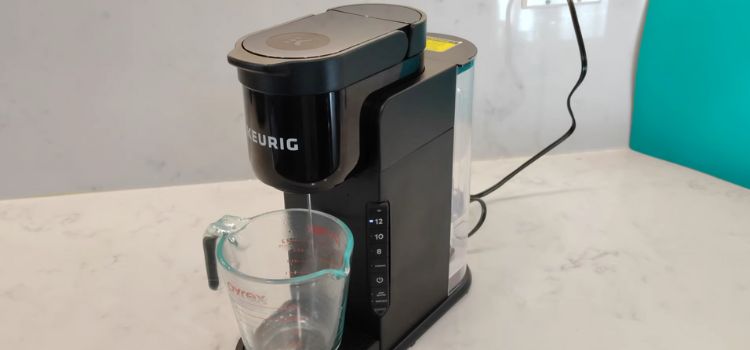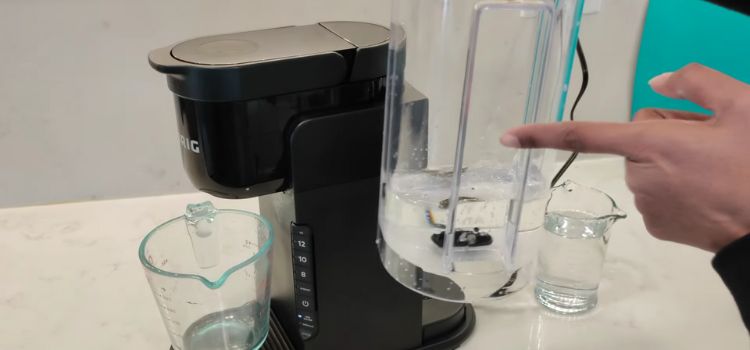As an Amazon Associate, I earn from qualifying purchases

For avid coffee enthusiasts, a Keurig machine is a treasured appliance that offers the luxury of a quick, personalized brew. However, this convenience comes with a need for regular maintenance, particularly descaling. Descaling is a crucial process that removes mineral deposits, primarily calcium and lime, which accumulate inside the machine over time.
These deposits can affect the taste of your coffee, slow down brewing times, and potentially damage your machine. Ignoring the descale light can lead to poor performance and ultimately shorten the lifespan of your Keurig. This article provides a comprehensive guide on how to turn off the descale light on your Keurig, ensuring you enjoy optimal coffee quality and machine functionality.
Understanding the Descale Light Indicator
The descale light on your Keurig serves as a timely reminder that it’s time to clean the machine. This light doesn’t indicate a malfunction but rather a preventative maintenance alert. Mineral buildup is a common issue, especially in areas with hard water. It’s essential to address this warning promptly to maintain your machine’s efficiency and the quality of your coffee.
Preparing for the Descaling Process
Before you begin the descaling process, gather the necessary materials to ensure a smooth operation. You’ll need a descaling solution or white vinegar, fresh water, and a large cup to catch the liquid. It’s important to note that while specialized descaling solutions are available, white vinegar is an effective and budget-friendly alternative.
Make sure your Keurig is powered off before you start. Unplugging the machine adds an extra layer of safety, ensuring no accidental activation during preparation.
Descaling Process
- Fill the Reservoir: Begin by removing the water reservoir from your Keurig. If using a commercial descaling solution, follow the instructions on the package to mix it with water. If you opt for white vinegar, fill the reservoir with equal parts vinegar and water. Reattach the reservoir to the machine.
- Run the Solution Through the Machine: Place a large cup on the drip tray to catch the descaling solution as it runs through the machine. Turn the machine on and select the largest brew size. Repeat this process until the reservoir is empty, allowing the solution to clean the internal components thoroughly.
- Rinse Thoroughly: After the descaling solution has passed through the machine, it’s crucial to rinse out any residue. Remove the reservoir, wash it with soap and water, and fill it with fresh water. Run at least two full reservoirs of clean water through the machine to ensure all traces of the descaling solution or vinegar are flushed out.
Resetting the Descale Light
Once you have completed the descaling process, you’ll need to reset the descale light. This step varies depending on the model of your Keurig. Typically, resetting involves holding down a button or a combination of buttons, such as the “Brew” button, until the light turns off. Refer to your user manual for specific instructions tailored to your model.
Troubleshooting Tips If the Descale Light Remains On
If the descale light remains illuminated after completing the process, there are a few troubleshooting steps you can take:
- Repeat the Descaling Process: It’s not uncommon for particularly stubborn mineral deposits to require a second round of descaling. Repeat the steps to ensure thorough cleaning.
- Check for Clogs or Blockages: Inspect the machine for any obstructions in the needle or water line that might be hindering the descaling process. Use a needle cleaning tool if necessary.
- Verify Proper Completion: Double-check that you followed each step of the descaling process correctly, including the reset procedure for the descale light.
Additional Tips for Maintaining Your Keurig Machine

Regular maintenance extends beyond descaling. Here are some additional tips to keep your Keurig in top condition:
- Regular Cleaning Routines: Regularly clean the machine’s exterior and removable parts such as the drip tray and pod holder. This helps prevent mold and bacteria growth.
- Usage of Filtered Water: Using filtered or bottled water can reduce mineral buildup and enhance the taste of your coffee.
- Scheduled Descaling Intervals: To prevent significant mineral buildup, descale your machine every three to six months. If you live in an area with hard water, consider more frequent descaling.
- How often should I descale my Keurig? Descaling should be done every three to six months, but if you notice slower brewing times, unusual noises, or poor coffee taste, you may need to descale more frequently.
- Can I use vinegar instead of a descaling solution? Yes, white vinegar is a popular alternative to commercial descaling solutions and is effective in removing mineral deposits.
- What are the signs that my Keurig needs descaling? Signs include a slower brewing process, unusual noises, and changes in coffee taste, indicating mineral buildup.
Conclusion
Maintaining your Keurig through regular descaling is essential for its longevity and performance. By following this guide, you can effectively turn off the descale light and keep your machine running smoothly.
Regular maintenance, including descaling and cleaning, ensures you enjoy the best coffee experience and prolongs the life of your Keurig. Always adhere to the manufacturer’s guidelines for optimal results, and enjoy your perfectly brewed cup every time.
As an Amazon Associate, I earn from qualifying purchases